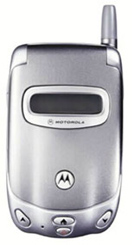| Review of the Motorola A388 |
| Review of the Motorola A388 |
 |
The Motorola A388 is one of a new breed of PDA Phones. That means is that it combines a PDA (Personal Digital Assistant) with a cell phone. Like all current attempts at convergence, the device is more of a compromise than it is the best of both worlds. Many thanks to Philip Litevsky for the loan of his Motorola A388. Last Updated: 27-Jul-2002 |
Before reading this review, please read Some Thoughts on Phone Reviewing.
Unlike most PDA Phones on the market however, the A388 is refreshingly phone-sized. In other words, you don't get the distinct feeling that you are holding a huge PDA to the side of your face when you talk on it. Although it isn't as small or as light as many dedicated phones, it is well within the size and weight tolerances for most people.
The unit is a clamshell design, but it does not have a keypad. It does have a small number of keys around the screen (which takes up virtually the entire surface of the phone's lower body). To use the unit as a phone, a keypad is simulated on the screen. While this may seem like a great solution, it's actually a good example of compromise.
The "keys" can be pressed using your fingers (rather than the provided stylus) but there is no tactile feel, and no feedback of any sort. If you need to press buttons during a call (to send touchtones) then you must manually select the keypad once the call is started. It isn't the kind of phone you want to use while trying to accomplish another task (such as driving). When you can put your full concentration on the phone, it works quite well.
Earpiece volume can be adjusted during a call using side-mounted buttons, but only if you haven't changed from the default screen that is displayed at the start of a call.
The PDA functionality of the phone is reasonably extensive, but I doubt that the A388 is going to win any awards in this department. It's best to think of the PDA functionality as an extension to the features found increasingly on regular cell phones.
The clamshell design is never my first pick, because inevitably it feels uncomfortable against some types of faces. I found the A388 to be acceptable in this regard, but the top of the clamshell feels flimsy to me, and I always had the feeling that I would damage the hinge if I continued to use it. While this may be more a perception than reality, it did give the phone a rather cheap feel.
n terms of RF performance, the phone did very well when compared to my P280. It had almost identical RF sensitivity, and it dealt with handoffs and network problems with similar aplomb. Unfortunately, the audio from the built-in earpiece was enormously disappointing. It was tinny and shallow, and it lacked any real volume. Fortunately though, the phone sounds great when used on a good-quality earbud or headset, but the volume is still rather low.
I liked the idea of a phone that was also a PDA, but I don't honestly believe the A388 is exactly the best attempt at this so far. It's poor audio quality (though the built-in speaker) and less-than-stellar PDA capabilities make it a mere blip on the radar of history. The market for this type of device is extremely competitive, and I believe that the A388 will look completely out-of-place in very short order. After all, people buying this type of phone aren't looking for a simple device, and their demands are high.
My apologies for the shortness of this review, but after deciding that it wasn't really my place to review the PDA portion of the phone, since I don't really have enough experience to pass judgment, I found myself left with little else to say.
Other Reviews of the Motorola A388
[None]